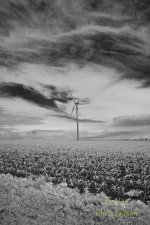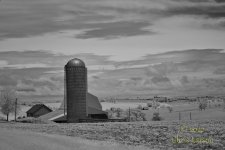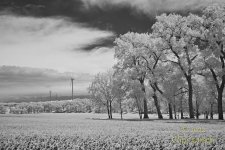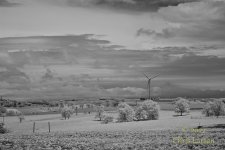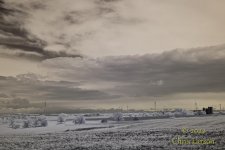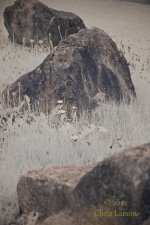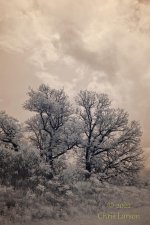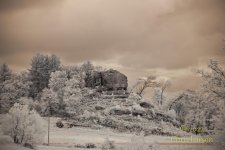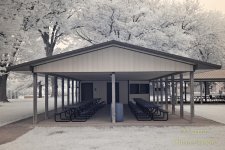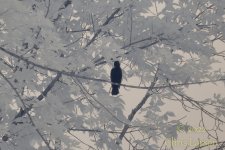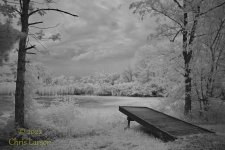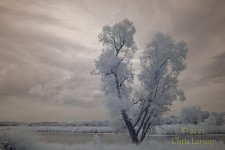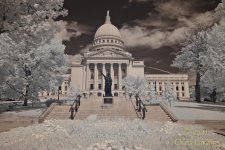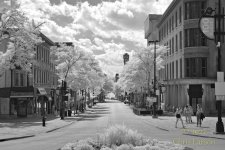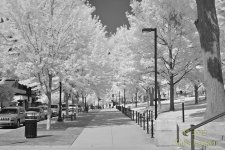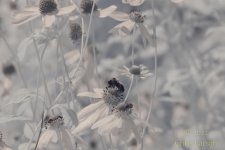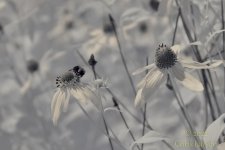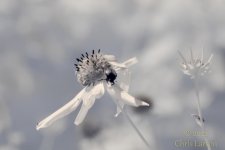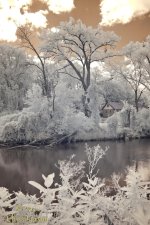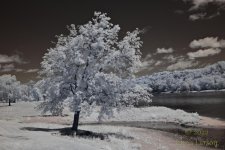You are using an out of date browser. It may not display this or other websites correctly.
You should upgrade or use an alternative browser.
You should upgrade or use an alternative browser.
Hammer's Interesting Infrareds
- Thread starter BF Hammer
- Start date
BF Hammer
Senior Member
A day of experimentation. I tried out my Zeiss 15mm f/2.8 Distagon on the IR D600. It has a hot-spot, so I don't think I will try that again. I hoped for good, dramatic clouds with storms in the day's forecast. The morning was simply a solid overcast with no texture.
Another wind farm near Freisland, WI. I have to stop hanging out around these places.
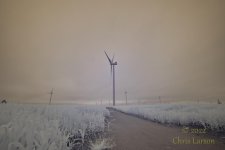
Watertown, WI later in the afternoon. Better clouds, composition needs a tractor or something in foreground. No extra charge for the raindrops on the lens.
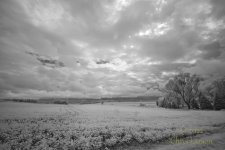
A mild fail with the Zeiss lens for IR shots. I will just have to continue using the Nikon 28-105mm f/3.5-4.5D as that is tried and proven at this point to behave well in IR.
Another wind farm near Freisland, WI. I have to stop hanging out around these places.

Watertown, WI later in the afternoon. Better clouds, composition needs a tractor or something in foreground. No extra charge for the raindrops on the lens.

A mild fail with the Zeiss lens for IR shots. I will just have to continue using the Nikon 28-105mm f/3.5-4.5D as that is tried and proven at this point to behave well in IR.
TwistedThrottle
Senior Member
Some very interesting shots! Whats the process for IR photography? I understand if its done with filters it's long exposure, blurred leaves, etc. Converted cameras, like yours allow you to shoot real time in IR, correct? Do you get a preview of the shot on the back of the camera? Once it hits your computer, whats it look like? I bet you could mess with the vignette slider to get rid of the hot spot in the wind farm shot. Real nice [MENTION=48483]BF Hammer[/MENTION] !
BF Hammer
Senior Member
Some very interesting shots! Whats the process for IR photography? I understand if its done with filters it's long exposure, blurred leaves, etc. Converted cameras, like yours allow you to shoot real time in IR, correct? Do you get a preview of the shot on the back of the camera? Once it hits your computer, whats it look like? I bet you could mess with the vignette slider to get rid of the hot spot in the wind farm shot. Real nice @BF Hammer !
Some fair questions there. Converting a camera involves removing the optical filter in front of the sensor which is supposed to block IR and pass visible, and substituting a new filter that will block most visible light and pass light in near-infrared and lower in frequency. My filter is of the 720nm type, which is a very traditional wavelength for the the IR cutoff. Many photographers opt for a shorter wavelength so more color will appear.
With a conversion, the camera basically just sees in a different wavelength and operates mostly the same. I normally just hand-hold and use A-Mode auto-exposure with auto-ISO just like I do with the other cameras. IR light does not refract the same way in lenses so some will work better than others. The autofocus has to be re-tuned and normally works better tuned with a lens you intend to use mainly. The big thing to keep in mind is white-balance. Auto white balance will pretty much make an all-magenta-toned image. I use preset white balance, and use a photo taken in green grass as the reference value for white. The preview on the camera back will show the image mostly correct. Of course the optical viewfinder is still a color composition. This conversion would be more ideal on a mirrorless body.
Processing the Raw image, you can tune the WB more by sampling any leafy plants in the image, as they should be white. Sunny skies will have a copper-color to it, and some browns appear. It is individual taste if you process with the IR conversion color pallete or desaturate to B/W. I look at the image and let it tell me which way I process it. I find with the D600 that it works better with extra contrast added and some highlights/shadows adjustments. Not too different than my color processing.
This D600 is really my 4th IR converted camera. My first was something I DIY-converted. I used a Coolpix 2200 and cut a piece of exposed/processed color print negative as my filter. It really worked, such as it was. That was done to determine if I would spend real money to professionally convert my Coolpix 995, and I did. Still have that 3.4MP camera, but it is limiting today. I converted a beat-up and well-used D80 professionally, and some months later it decided to die on me. Last year I decided I was not done playing in IR yet, so I shopped for weeks looking for a used camera already converted by somebody else. That is how I wound up with this current D600.
TwistedThrottle
Senior Member
Great info, thanks! I like the effect it gives, its very unique. I especially like the dock shot, and the sidewalk shot just pops! When you say the autofocus has to be re-tuned, is that something you adjust in camera yourself or does it need to be sent in somewhere? Is it just trial and error on what lenses work best? Seems a prime, especially a zeiss would be a better choice than a screw drive zoom, but I think I see what you mean about different wavelengths being handled differently lens to lens.
BF Hammer
Senior Member
When you say the autofocus has to be re-tuned, is that something you adjust in camera yourself or does it need to be sent in somewhere? Is it just trial and error on what lenses work best? Seems a prime, especially a zeiss would be a better choice than a screw drive zoom, but I think I see what you mean about different wavelengths being handled differently lens to lens.
The places that do the conversion services mention sort of up-front that they should tune the autofocus to a specific lens you plan to use, or they can do a general re-tune if you don't have a specific lens at that time. I understand this as being a hand-tuned thing rather than the focus-tuning on the camera menu of some cameras.
When I bought this D600, it was body only from KEH. I only had a couple of full-frame lenses appropriate for wide-normal range at the time, and was more planning to find a crop-sensor body. So I decided to buy a cheap used FX kit lens at my local camera store, and went shopping. I brought the camera to test the lenses in store, and have been very pleased with the 28-105mm lens for this purpose. It is truly a landscape camera, so fast autofocus is not mandatory. FWIW I also have used a 50mm f/1.8G and it is a good option. But the zoom lens has been so satisfactory that I don't see the need to swap the 50mm in. I should try out my 70-200mm f/2.8 sometime just to find out if it looks OK in IR. I did a moon photo with an old 500mm reflex lens and as-predicted, it was very good with IR.

